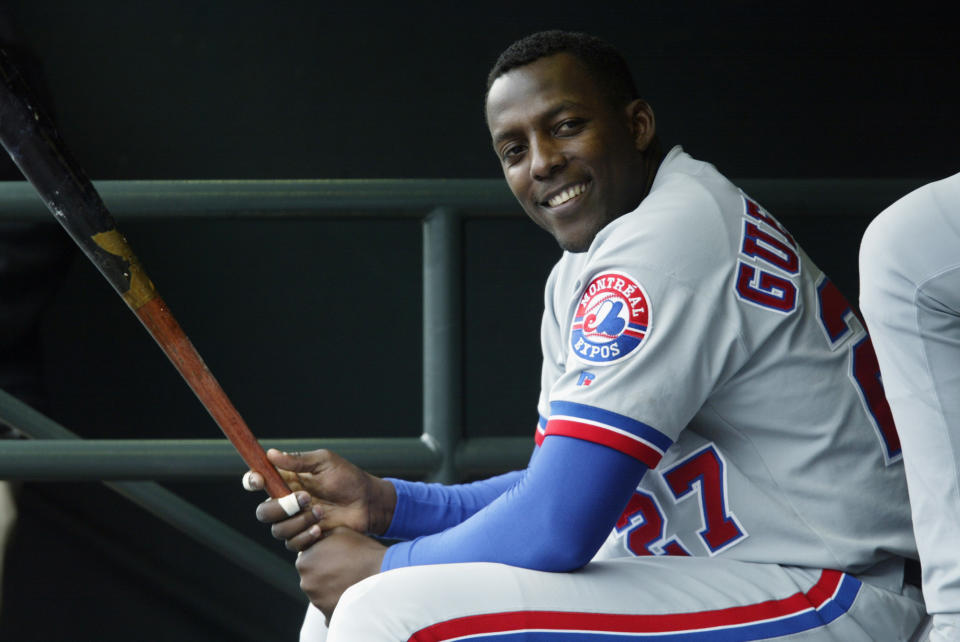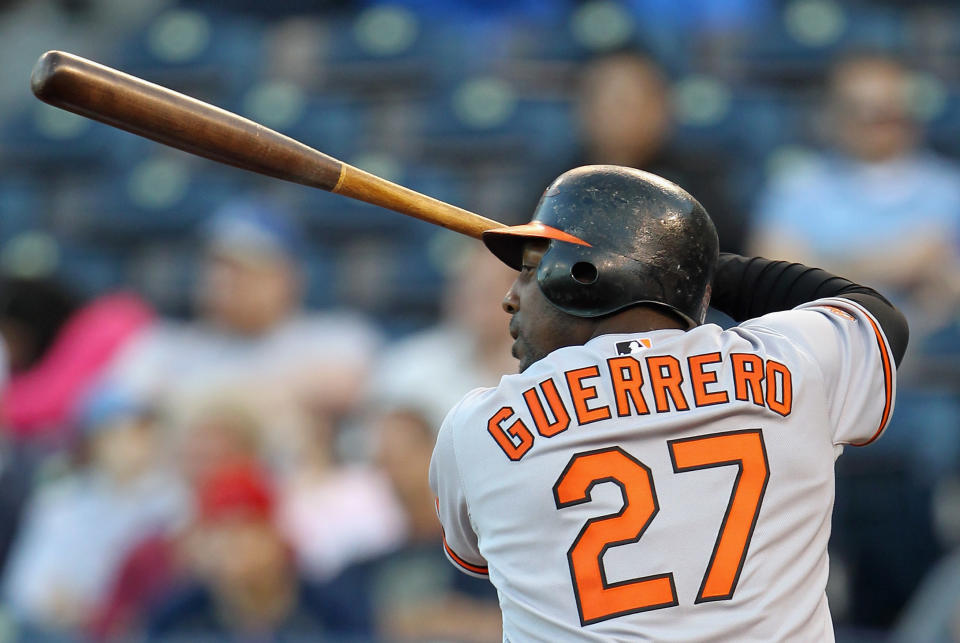The theater of Vladimir Guerrero
The story has undoubtedly grown wings over the decades, Jim Tracy would admit, the way old stories sprout fresh feathers, but he loves telling it nonetheless. It’s about Vladimir Guerrero, see, and Vlad has always been happy enough to have others tell his story, as that released him from having to tell it. Then he could stand off to the side, shy, his smile broad, nodding, yeah that really happened, no big deal, what time’s the game?
This one has Montreal Expos scouts in the Dominican Republic in the mid-’90s. They’d hold a tryout for a few dozen of the local boys, most of them skinny and eager to please. To some, baseball would mean three meals and real beds and wood floors and enough money to provide the same back home. So, more than just eager, probably.
Near the end of one of those days, one of the scouts would say to another something like, “See anything? Who’s good?”
“Maybe,” the other would say. “The best one in the area though, he didn’t try out.”
“Why not? Who’s that?”
And the scout nodded to the tall, lanky kid on the back of an old motorcycle (or bicycle, depending on who’s doing the remembering), watching. He wore mismatched shoes – or no shoes, according to some versions of the story – and his feet were, said Tracy, “Flatter than the road he was standing on.”
Here Tracy chuckled and said, “Reminds me of Kelly Leak, when Walter Matthau asked him to come out.”
The scouts waved the kid from the motorcycle, onto the field. He ambled toward them, his eyes low. They handed him a baseball and asked him to throw it, far as he could. They handed him a bat and asked him to swing it, hard as he could. Then they gave him a pair of shoes and $2,500.

“The damnedest thing,” said Tracy, a coach on the Expos’ staff when Guerrero arrived three years later in the major leagues. “I don’t know that there could be a greater journey, from being that barefoot kid in Santo Domingo to Cooperstown.”
Take away, just for the moment, the baseball Vladimir Guerrero accumulated over 16 years. The 449 home runs. The 2,590 hits. The 181 steals. The 126 outfield assists. The .318 average. The AL MVP trophy. Forget, for this moment, all of that, even if today, the day he became a Hall of Famer, is a day for all of that.
Remember the uniqueness of Vlad. The theater of Vlad. Remember how he started from the on-deck circle with that off-center, Erector Set, Fred Sanford gait and how you thought to yourself, every single time, “Well, this will be interesting.”
Legs too long. Arms too long. Butt too high. Smile too sincere. Bat too big. No gloves. How’s a man gonna hit with no gloves in 2005?
In his time, there’d be better hitters. There’d be better players. Only a few. But they were out there. Nobody, though, ever, looked quite like Vlad, played quite like Vlad, hit quite like Vlad, lunged, spun, lifted, separated, hacked, emergency-hacked, DEFCON 1-hacked and flat put the barrel on the ball quite like Vlad. Genius, it was. A gift, too. One at-bat he’d finish standing straight up, having hands-ed to the left-field line a pitch that might otherwise have clipped his visor, the next he’d finish like he’d broomed a marble from under the sofa, that ball looping toward right. When Vlad was a rookie, F.P. Santangelo recalled, he wasn’t even all that partial to which bat he’d use. When it was his time to hit, he’d browse through the bat rack, pluck out a bat, weigh it in his hands, wag it a little, then raise his eyebrows toward the owner, like, “Can I?”
“Sometimes he’d use five different bats in a game,” Santangelo said. “Then go up and swing at the first pitch.”
Remember that it was a duty to watch, because it was a joy to watch, and not just because the ball might go a long way (which it might) or because the game was on the line, but because Vlad was probably going to figure it out, and also because it was going to be epic either way, and it was going to happen quickly. That year – 2004 – he was American League MVP. He dawdled in the box for an average of 3.17 pitches. And he was the guy nobody wanted to pitch to. Only they couldn’t help it, because they were going to have to let go of the baseball eventually, and Vlad would make do. Then the guy whose only other option was to just heave the ball over the backstop would stand on the mound with his hands on his hips, staring at his catcher, while Vlad arrived at second base in seven strides.
“Awesome to see,” Garret Anderson recalled.
Anderson hit behind Guerrero almost every night for five years, more often than anyone. He’d make as much sense as he could of the two or three or four (or one) pitch he’d witness, and marvel at how their two swings could not have been more different – Anderson’s coolly smooth, Vlad’s a rush and blur of body parts, and count the hits along with everyone else.
“He’s just one of the most gifted hitters I ever played with,” Anderson said. “First of all, it was a gift. And he was very smart. He didn’t just swing the bat to swing the bat. He was in actuality looking for a ball to hit.”
Vlad’s batting practice was “professional,” Anderson said. Big parts of the field. Left-center to right-center. Then, come game time, he’d top-spin that inner-half fastball into the left-field seats. His 400th home run hit the right-field foul pole in Anaheim. Along the way, he’d go everywhere in between, too, fighting for every inch of the strike zone, and fighting for the half-foot around it, too, so that it seemed every at-bat would end covered in dirt and pine tar and spit and drama.
“I’m not saying he was perfect,” Anderson said. “But it was awesome to see. And the first thing, he was the most unassuming superstar that I knew. He never boasted. He just loved playing baseball. There wasn’t all that extra nonsense to go with it.
“You’d see him get frustrated. See him get mad. Then he would turn the page every day. He was what he was. Every day. What you saw is what I saw.”
What everyone saw.

“He was playing Wiffle ball in somebody’s backyard,” said Santangelo, who hit behind Vlad in Vlad’s big-league debut, and meaning it as a compliment. “We’re playing in the major leagues and feeling it. Grinding. Working counts. Probably overthinking every at-bat over the whole year. He was playing Wiffle ball. There’s so much beauty in the simplicity in the way he approached the game. He just played baseball and kept it simple.”
On a September day in 1996, the Expos were at Olympic Stadium, and young Vlad’s big-league career was a day or so away.
“He was just a baby,” Tracy recalled.
The manager, Felipe Alou, called a meeting of the coaching staff in his office. When the coaches arrived, Alou was sitting behind his desk. He looked serious. Someone pulled the door closed. The coaches shot sideways glances at each other.
Alou began.
“Leave. The. Kid. Alone.”
Alou nodded. Maybe 20 seconds. Meeting over. Tracy and the rest turned and left.
What followed, you know. The thunderous bat. The big arm. The cleverness. The joy. The career that took off, and yet never seemed to carry him too far from the kid who’d been talked into that tryout.
“Vlad never game me the impression,” Tracy said, “he had a bad day.”
Throw the ball as far as you can. Hit it as far as you can. Show up tomorrow and try it again, this time with shoes and a little money in your pocket. But, always, always, enjoy it, the theater of Vlad.
More Hall of Fame coverage from Yahoo Sports:
• Four baseball greats become Hall of Famers
• Ex-Braves star’s ‘crazy’ Hall of Fame ride
• Can Schilling overcome his mouth to make Hall of Fame?
• Bonds, Clemens hit roadblock on path to Hall

